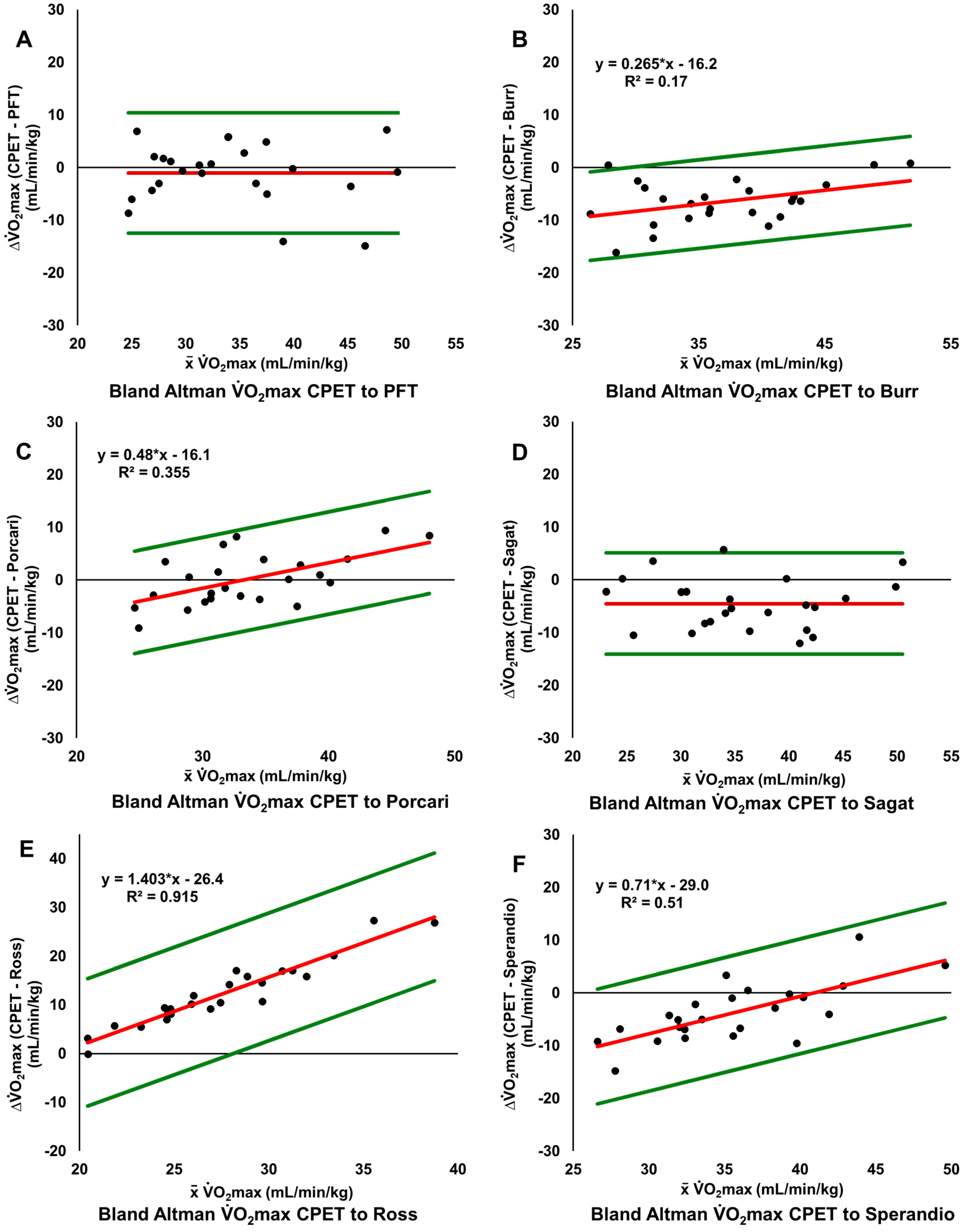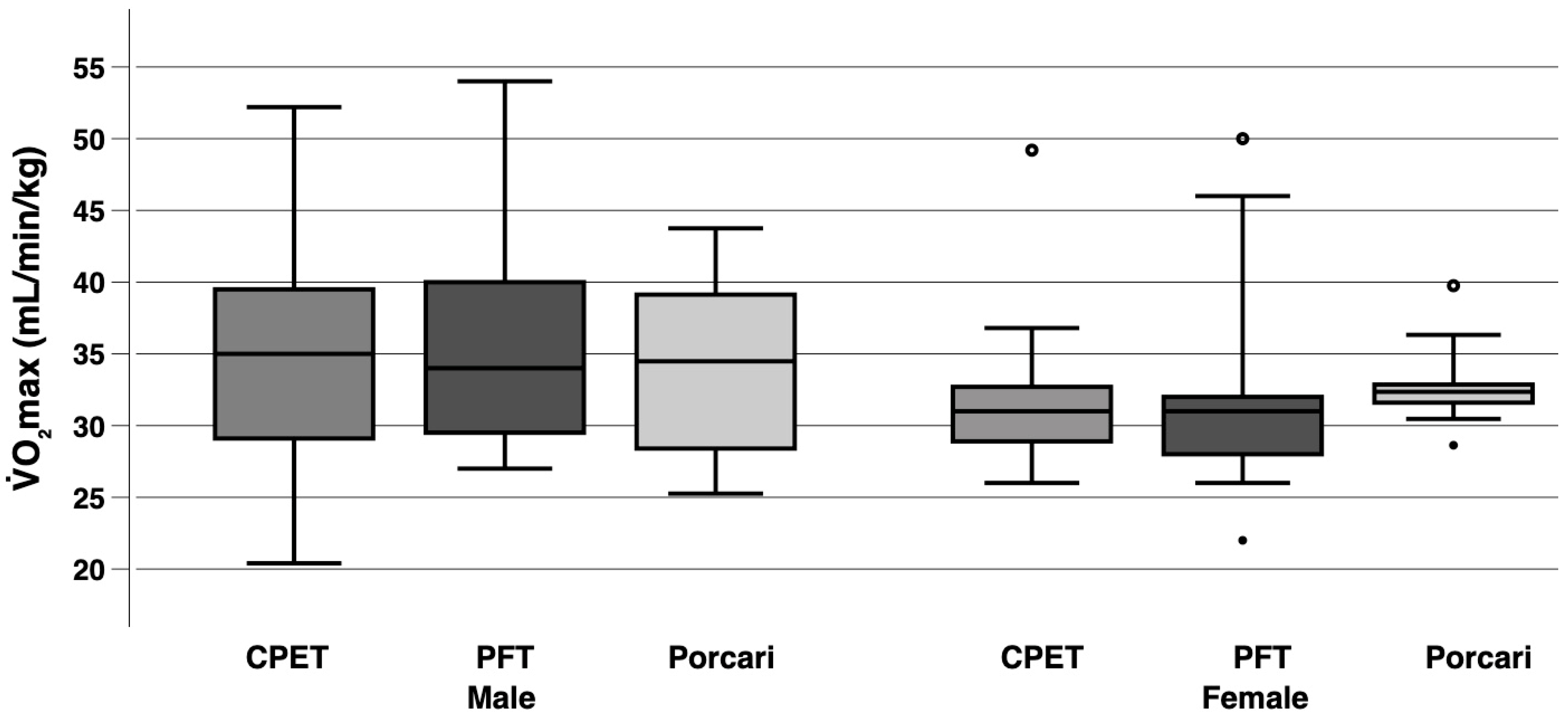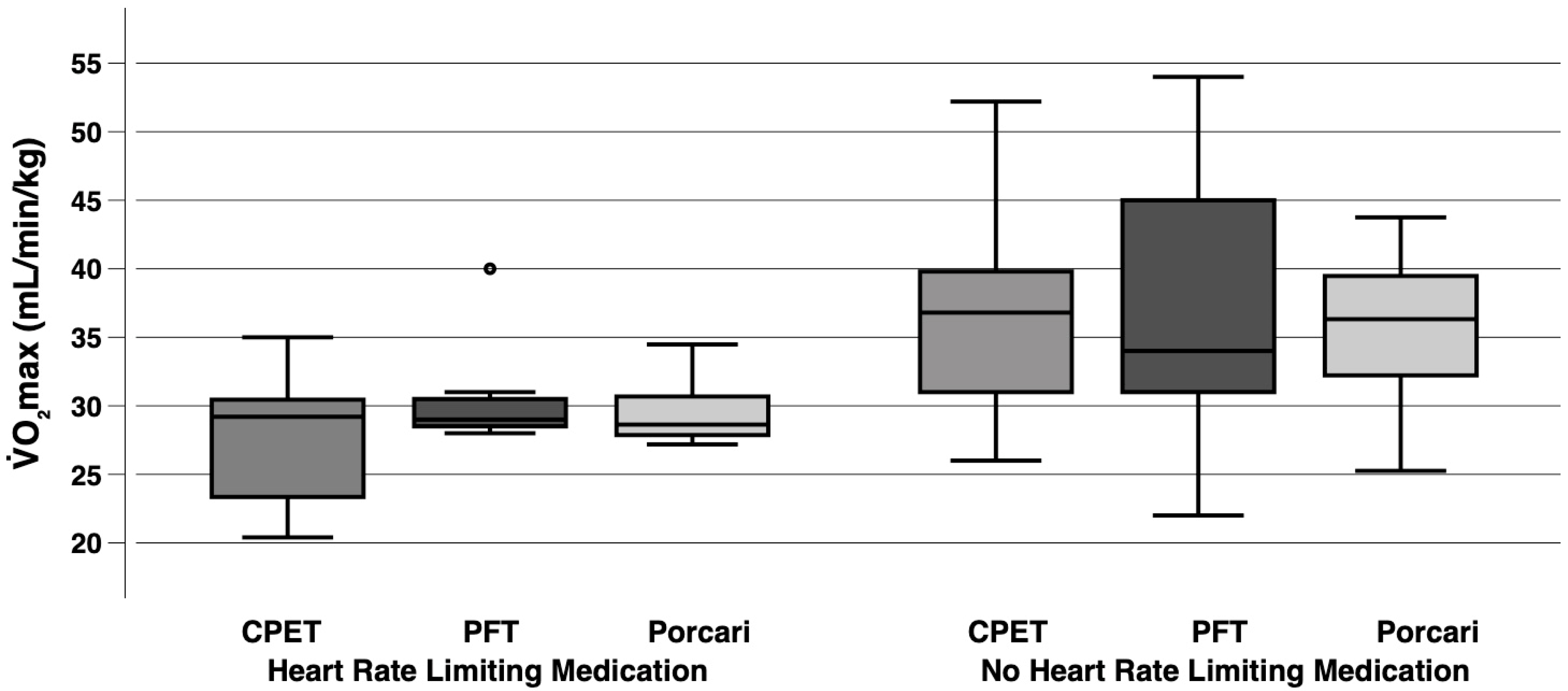Validation of the Polar Fitness Test for Estimation of Maximal Oxygen Consumption at Rest in Medically Supervised Exercise Training: Comparison with CPET and the 6-Minute Walk Test †
Abstract
1. Introduction
2. Materials and Methods
2.1. Study Design
2.2. Participants
2.3. Study Protocol
2.3.1. Medical Examination
2.3.2. Sensor Placement and PFT
2.3.3. Treadmill Test CPET
2.3.4. Secondary Criteria Used to Validate O2max
2.3.5. 6-Minute Walk Test
2.3.6. 6-Minute Walk Test Based O2max Estimation Equations
| Author (Year of Publication) | O2max Estimation Equation |
|---|---|
| Burr et al. [42] (2011) | O2max = 70.161 + (0.023 × 6MWT [m]) − (0.276 × weight [kg]) − (6.79 × sex [m = 0, f = 1]) − (0.193 × resting HR [bpm]) − (0.191 × age [y]) |
| Porcari et al. [40] (2021) | MaxMETs = 0.882 + (0.018 × 6MWT [m]) − (0.308 × RPE); O2max calculated by multiplying METs by 3.5 |
| Sagat et al. [41] (2023) | O2max = 59.44 − 3.83 × sex [1 = men; 2 = women]) − 0.56 × age [years] − 0.48 × BMI [kg/m2] + 0.04 × 6MWT [m] |
| Ross et al. [38] (2010) | O2peak = 4.948 + 0.023 × 6MWT [m] |
| Sperandio et al. [39] (2015) | O2peak = −2.863 + (0.0563 × 6MWT [m]) |
2.4. Statistics
3. Results
3.1. Participants
3.2. Validity of O2max Estimation by PFT and 6MWT-Based Equations
3.3. Exploratory Analysis of Determinants Contributing to the Inaccuracy of the PFT: Sex
3.4. Exploratory Analysis of Determinants Contributing to the Inaccuracy of the PFT: Heart Rate-Limiting Medication
4. Discussion
4.1. 6MWT Equation-Based O2max Estimates
4.2. Exploratory Analysis by Sex and Heart Rate–Limiting Medication
4.3. Study Limitations
5. Conclusions
Author Contributions
Funding
Institutional Review Board Statement
Informed Consent Statement
Data Availability Statement
Acknowledgments
Conflicts of Interest
Disclaimer
References
- Millet, G.P.; Burtscher, J.; Bourdillon, N.; Manferdelli, G.; Burtscher, M.; Sandbakk, Ø. The O2max Legacy of Hill and Lupton (1923)—100 Years On. Int. J. Sports Physiol. Perform. 2023, 18, 1362–1365. [Google Scholar] [CrossRef]
- Bayles, M.P. ACSM’s Exercise Testing and Prescription; Lippincott Williams & Wilkins: Philadelphia, PA, USA, 2023. [Google Scholar]
- Kaminsky, L.A.; German, C.; Imboden, M.; Ozemek, C.; Peterman, J.E.; Brubaker, P.H. The importance of healthy lifestyle behaviors in the prevention of cardiovascular disease. Prog. Cardiovasc. Dis. 2022, 70, 8–15. [Google Scholar] [CrossRef] [PubMed]
- Spathis, D.; Perez-Pozuelo, I.; Gonzales, T.I.; Wu, Y.; Brage, S.; Wareham, N.; Mascolo, C. Longitudinal cardio-respiratory fitness prediction through wearables in free-living environments. NPJ Digit. Med. 2022, 5, 1–11. [Google Scholar] [CrossRef]
- Mandsager, K.; Harb, S.; Cremer, P.; Phelan, D.; Nissen, S.E.; Jaber, W. Association of Cardiorespiratory Fitness With Long-term Mortality Among Adults Undergoing Exercise Treadmill Testing. JAMA Netw. Open 2018, 1, e183605. [Google Scholar] [CrossRef]
- Kokkinos, P.; Faselis, C.; Samuel, I.B.H.; Pittaras, A.; Doumas, M.; Murphy, R.; Heimall, M.S.; Sui, X.; Zhang, J.; Myers, J. Cardiorespiratory Fitness and Mortality Risk Across the Spectra of Age, Race, and Sex. JACC 2022, 80, 598–609. [Google Scholar] [CrossRef]
- Meyler, S.J.R.; Swinton, P.A.; Bottoms, L.; Dalleck, L.C.; Hunter, B.; Sarzynski, M.A.; Wellsted, D.; Williams, C.J.; Muniz-Pumares, D. Changes in Cardiorespiratory Fitness Following Exercise Training Prescribed Relative to Traditional Intensity Anchors and Physiological Thresholds: A Systematic Review with Meta-analysis of Individual Participant Data. Sports Med. 2024, 55, 301–323. [Google Scholar] [CrossRef]
- Kokkinos, P.; Faselis, C.; Samuel, I.B.H.; Lavie, C.J.; Zhang, J.; Vargas, J.D.; Pittaras, A.; Doumas, M.; Karasik, P.; Moore, H.; et al. Changes in Cardiorespiratory Fitness and Survival in Patients With or Without Cardiovascular Disease. JACC 2023, 81, 1137–1147. [Google Scholar] [CrossRef] [PubMed]
- McDonagh, T.A.; Metra, M.; Adamo, M.; Gardner, R.S.; Baumbach, A.; Böhm, M.; Burri, H.; Butler, J.; Čelutkienė, J.; Chioncel, O.; et al. 2021 ESC Guidelines for the diagnosis and treatment of acute and chronic heart failure. Eur Heart J. 2021, 42, 3599–3726. [Google Scholar] [CrossRef] [PubMed]
- Ross, R.; Blair, S.N.; Arena, R.; Church, T.S.; Despres, J.P.; Franklin, B.A.; Haskell, W.L.; Kaminsky, L.A.; Levine, B.D.; Lavie, C.J.; et al. Importance of Assessing Cardiorespiratory Fitness in Clinical Practice: A Case for Fitness as a Clinical Vital Sign: A Scientific Statement From the American Heart Association. Circulation 2016, 134, e653–e699. [Google Scholar] [CrossRef]
- Kirsten, J.; Wais, V.; Schulz, S.V.; Sala, E.; Treff, G.; Bunjes, D.; Steinacker, J.M. Sarcopenia Screening Allows Identifying High-Risk Patients for Allogenic Stem Cell Transplantation. Cancers 2021, 13, 1771. [Google Scholar] [CrossRef]
- Harber, M.P.; Myers, J.; Bonikowske, A.R.; Muntaner-Mas, A.; Molina-Garcia, P.; Arena, R.; Ortega, F.B. Assessing cardiorespiratory fitness in clinical and community settings: Lessons and advancements in the 100th year anniversary of VO2max. Prog. Cardiovasc. Dis. 2024, 83, 36–42. [Google Scholar] [CrossRef] [PubMed]
- Altuwaijri, T. Prehabilitation to Enhance Vascular Surgery Outcomes: A Narrative Review. Cureus 2024, 16, e70200. [Google Scholar] [CrossRef]
- Poole, D.C.; Jones, A.M. Measurement of the maximum oxygen uptake o2max: o2peak is no longer acceptable. J. Appl. Physiol. 2017, 122, 997–1002. [Google Scholar] [CrossRef]
- Rapin, A.; Etossé, A.; Tambosco, L.; Nicomette, J.; Percebois-Macadré, L.; Mouret, P.; Boyer, F. Aerobic capacities and exercise tolerance in neuromuscular diseases: A descriptive study. Ann. Phys. Rehabilitation Med. 2013, 56, 420–433. [Google Scholar] [CrossRef][Green Version]
- Wenzel, C.; Bongers, B.C.; Schlagheck, M.L.; Reis, D.; Reinhard, F.; Schmidt, P.; Bernitzki, S.; Oberste, M.; Wunram, H.L.; Zimmer, P.; et al. Validation of the maximal cardiopulmonary exercise test in adolescents with major depressive disorder and comparison of cardiorespiratory fitness with sex- and age-related control values. Eur. J. Pediatr. 2023, 183, 379–388. [Google Scholar] [CrossRef]
- Guazzi, M.; Arena, R.; Halle, M.; Piepoli, M.F.; Myers, J.; Lavie, C.J. 2016 Focused Update: Clinical Recommendations for Cardiopulmonary Exercise Testing Data Assessment in Specific Patient Populations. Circulation 2016, 133, e694–e711. [Google Scholar] [CrossRef]
- Bennett, H.; Parfitt, G.; Davison, K.; Eston, R. Validity of Submaximal Step Tests to Estimate Maximal Oxygen Uptake in Healthy Adults. Sports Med. 2015, 46, 737–750. [Google Scholar] [CrossRef]
- Molina-Garcia, P.; Notbohm, H.L.; Schumann, M.; Argent, R.; Hetherington-Rauth, M.; Stang, J.; Bloch, W.; Cheng, S.; Ekelund, U.; Sardinha, L.B.; et al. Validity of Estimating the Maximal Oxygen Consumption by Consumer Wearables: A Systematic Review with Meta-analysis and Expert Statement of the INTERLIVE Network. Sports Med. 2022, 52, 1577–1597. [Google Scholar] [CrossRef] [PubMed]
- Laricchia, F. Wearable Shipments Worldwide 2028. 2024. Available online: https://www.statista.com/statistics/437871/wearables-worldwide-shipments/ (accessed on 1 July 2025).
- Polar®. Polar Fitness Test (White Paper). 2019. Available online: https://www.polar.com/img/static/whitepapers/pdf/polar-fitness-test-white-paper.pdf?srsltid=AfmBOoqmlHN0oHZFZW1VpRZ0bNod0ytkWMGRcN7NCMsQ9PClN5z4bwBb (accessed on 1 July 2025).
- Daniels, K.; Rathore, F.A.; Bonnechère, B. Mobile health: Is your next rehabilitation’s specialist in your pocket? J. Pak. Med Assoc. 2024, 74, 599–601. [Google Scholar] [CrossRef] [PubMed]
- Bonnechère, B.; Rintala, A.; Spooren, A.; Lamers, I.; Feys, P. Is mHealth a Useful Tool for Self-Assessment and Rehabilitation of People with Multiple Sclerosis? A Systematic Review. Brain Sci. 2021, 11, 1187. [Google Scholar] [CrossRef]
- Kammin, E.J. The 6-Minute Walk Test: Indications and Guidelines for Use in Outpatient Practices. J. Nurse Pract. 2022, 18, 608–610. [Google Scholar] [CrossRef]
- Bossuyt, P.M.; Reitsma, J.B.; Bruns, D.E.; Gatsonis, C.A.; Glasziou, P.P.; Irwig, L.; Lijmer, J.G.; Moher, D.; Rennie, D.; de Vet, H.C.W.; et al. STARD 2015: An updated list of essential items for reporting diagnostic accuracy studies. BMJ 2015, 351, h5527. [Google Scholar] [CrossRef]
- World Medical Association. World Medical Association Declaration of Helsinki: Ethical principles for medical research involving human subjects. JAMA 2013, 310, 2191–2194. [Google Scholar] [CrossRef]
- Neudorfer, M.; Kumar, D.; Smeddinck, J.D.; Kulnik, S.T.; Niebauer, J.; Treff, G.; Sareban, M. Validity of Four Consumer-Grade Optical Heart Rate Sensors for Assessing Volume and Intensity Distribution of Physical Activity. Scand. J. Med. Sci. Sports 2024, 34, e14756. [Google Scholar] [CrossRef]
- Bujang, M.A.; Baharum, N. A simplified guide to determination of sample size requirements for estimating the value of intraclass correlation coefficient: A review. Arch. Orofac. Sci. 2017, 12, 1–11. [Google Scholar]
- Koo, T.K.; Li, M.Y. A Guideline of Selecting and Reporting Intraclass Correlation Coefficients for Reliability Research. J. Chiropr. Med. 2016, 15, 155–163. [Google Scholar] [CrossRef] [PubMed]
- Merck & Co Fitzpatrick Skin Type Classification, MSD Manual Consumer Version. 2023. Available online: https://www.msdmanuals.com/home/SearchResults?query=fitzpatrick+skin+type (accessed on 27 July 2023).
- Nystrom, M. Polar Precision Prime. Polar, 2019. Available online: https://www.polar.com/blog/optical-heart-rate-monitoring-polar-precision-prime/?srsltid=AfmBOopQqkeDHV2VisaYCdzbrs0WQUXKAKbGBWPXRYXq2ShQyZolq_rN (accessed on 18 August 2025).
- Bruce, R.A.; Kusumi, F.; Hosmer, D. Maximal oxygen intake and nomographic assessment of functional aerobic impairment in cardiovascular disease. Am. Heart J. 1973, 85, 546–562. [Google Scholar] [CrossRef]
- Williams, N. The Borg Rating of Perceived Exertion (RPE) scale. Occup. Med. 2017, 67, 404–405. [Google Scholar] [CrossRef]
- Hesse, C.M.; Tinius, R.A.; Pitts, B.C.; Olenick, A.A.; Blankenship, M.M.; Hoover, D.L.; Maples, J.M. Assessment of endpoint criteria and perceived barriers during maximal cardiorespiratory fitness testing among pregnant women. J. Sports Med. Phys. Fit. 2018, 58, 1844–1851. [Google Scholar] [CrossRef] [PubMed]
- Howley, E.T.; Bassett, D.R.; Welch, H.G. Criteria for maximal oxygen uptake: Review and commentary. Med. Sci. Sports Exerc. 1995, 27, 1292–1301. [Google Scholar] [CrossRef] [PubMed]
- Tanaka, H.; Monahan, K.D.; Seals, D.R. Age-predicted maximal heart rate revisited. JACC 2001, 37, 153–156. [Google Scholar] [CrossRef]
- Edvardsen, E.; Hem, E.; Anderssen, S.A.; Reddy, H. End Criteria for Reaching Maximal Oxygen Uptake Must Be Strict and Adjusted to Sex and Age: A Cross-Sectional Study. PLoS ONE 2014, 9, e85276. [Google Scholar] [CrossRef]
- Ross, R.M.; Murthy, J.N.; Wollak, I.D.; Jackson, A.S. The six minute walk test accurately estimates mean peak oxygen uptake. BMC Pulm. Med. 2010, 10, 31. [Google Scholar] [CrossRef] [PubMed]
- Rosa, F.E.; Santos, R.M.; Rogatto, S.R.; Domingues, M.A.C. Chromogenic in Situ Hybridization Compared with Other Approaches to Evaluate HER2/Neu Status in Breast Carcinomas. Braz. J. Med. Biol. Res. 2013, 46, 207–216. [Google Scholar] [CrossRef]
- Porcari, J.P.; Foster, C.; Cress, M.L.; Larson, R.; Lewis, H.; Cortis, C.; Doberstein, S.; Donahue, M.; Fusco, A.; Radtke, K. Prediction of Exercise Capacity and Training Prescription from the 6-Minute Walk Test and Rating of Perceived Exertion. J. Funct. Morphol. Kinesiol. 2021, 6, 52. [Google Scholar] [CrossRef] [PubMed]
- Šagát, P.; Kalčik, Z.; Bartik, P.; Šiška, Ľ.; Štefan, L. A Simple Equation to Estimate Maximal Oxygen Uptake in Older Adults Using the 6 min Walk Test, Sex, Age and Body Mass Index. J. Clin. Med. 2023, 12, 4476. [Google Scholar] [CrossRef]
- Burr, J.F.; Bredin, S.S.D.; Faktor, M.D.; Warburton, D.E.R. The 6-Minute Walk Test as a Predictor of Objectively Measured Aerobic Fitness in Healthy Working-Aged Adults. Physician Sportsmed. 2011, 39, 133–139. [Google Scholar] [CrossRef]
- Sartor, F.; Gelissen, J.; van Dinther, R.; Roovers, D.; Papini, G.B.; Coppola, G. Wrist-worn optical and chest strap heart rate comparison in a heterogeneous sample of healthy individuals and in coronary artery disease patients. BMC Sports Sci. Med. Rehabilitation 2018, 10, 1–10. [Google Scholar] [CrossRef]
- Mühlen, J.M.; Stang, J.; Skovgaard, E.L.; Judice, P.B.; Molina-Garcia, P.; Johnston, W.; Sardinha, L.B.; Ortega, F.B.; Caulfield, B.; Bloch, W.; et al. Recommendations for determining the validity of consumer wearable heart rate devices: Expert statement and checklist of the INTERLIVE Network. Br. J. Sports Med. 2021, 55, 767–779. [Google Scholar] [CrossRef]
- ANSI/CTA-2065; ANSI/CTA Standard. Physical Activity Monitoring for Heart Rate. Consumer Technology Association: Arlington, VA, USA, 2018. Available online: https://www.cta.tech/standards/ansicta-20651/ (accessed on 1 July 2022).
- Jalilibal, Z.; Amiri, A.; Castagliola, P.; Khoo, M.B. Monitoring the coefficient of variation: A literature review. Comput. Ind. Eng. 2021, 161, 107600. [Google Scholar] [CrossRef]
- Passler, S.; Bohrer, J.; Blöchinger, L.; Senner, V. Validity of Wrist-Worn Activity Trackers for Estimating VO2max and Energy Expenditure. Int. J. Environ. Res. Public Heal. 2019, 16, 3037. [Google Scholar] [CrossRef] [PubMed]
- Nelson, M.B.; Kaminsky, L.A.; Dickin, D.C.; Montoye, A.H.K. Validity of Consumer-Based Physical Activity Monitors for Specific Activity Types. Med. Sci. Sports Exerc. 2016, 48, 1619–1628. [Google Scholar] [CrossRef]
- Arena, R.; Sietsema, K.E. Cardiopulmonary Exercise Testing in the Clinical Evaluation of Patients With Heart and Lung Disease. Circulation 2011, 123, 668–680. [Google Scholar] [CrossRef]
- Nilsson, B.B.; Lunde, P.; Grøgaard, H.K.; Holm, I. Long-Term Results of High-Intensity Exercise-Based Cardiac Rehabilitation in Revascularized Patients for Symptomatic Coronary Artery Disease. Am. J. Cardiol. 2018, 121, 21–26. [Google Scholar] [CrossRef]
- Laukkanen, J.A.; Zaccardi, F.; Khan, H.; Kurl, S.; Jae, S.Y.; Rauramaa, R. Long-term Change in Cardiorespiratory Fitness and All-Cause Mortality. Mayo Clin. Proc. 2016, 91, 1183–1188. [Google Scholar] [CrossRef] [PubMed]
- Sian, T.S.; Inns, T.; Gates, A.; Doleman, B.; Gharahdaghi, N.; Atherton, P.J.; Lund, J.N.; Phillips, B.E. Short-Term, Equipment-Free High Intensity Interval Training Elicits Significant Improvements in Cardiorespiratory Fitness Irrespective of Supervision in Early Adulthood. Front. Sports Act. Living 2021, 3, 697518. [Google Scholar] [CrossRef] [PubMed]
- Gimeno-Santos, E.; Coca-Martinez, M.; Arguis, M.J.; Navarro, R.; Lopez-Hernandez, A.; Castel, M.A.; Romano, B.; Lopez-Baamonde, M.; Sandoval, E.; Farrero, M.; et al. Multimodal prehabilitation as a promising strategy for preventing physical deconditioning on the heart transplant waiting list. Eur. J. Prev. Cardiol. 2020, 27, 2367–2370. [Google Scholar] [CrossRef]
- Hansen, M.T.; Rømer, T.; Højgaard, A.; Husted, K.; Sørensen, K.; Schmidt, S.E.; Dela, F.; Helge, J.W. Validity and reliability of seismocardiography for the estimation of cardiorespiratory fitness. Cardiovasc. Digit. Heal. J. 2023, 4, 155–163. [Google Scholar] [CrossRef]




| Male (n = 15) | Female (n = 9) | Total (n = 24) | |||||||
|---|---|---|---|---|---|---|---|---|---|
| Age (years) | 59.5 | ± | 9.8 | 54 | ± | 10.4 | 57.4 | ± | 10.2 |
| Height (cm) | 176.7 | ± | 4.4 | 165.7 | ± | 5.6 | 172.6 | ± | 7.2 |
| Body mass (kg) | 84.2 | ± | 14.4 | 67.3 | ± | 13.3 | 77.8 | ± | 16.0 |
| BMI (kg/m2) | 27.0 | ± | 4.4 | 24.3 | ± | 3.6 | 26.0 | ± | 4.2 |
| O2maxCPET (mL/min/kg) | 34.3 | ± | 8.5 | 32.7 | ± | 6.9 | 33.7 | ± | 7.8 |
| HRmax (bpm) | 156.2 | ± | 20.3 | 171.3 | ± | 14.9 | 161.9 | ± | 19.6 |
| 6MWT distance (m) | 730.4 | ± | 86.4 | 693 | ± | 33.8 | 716.4 | ± | 72.7 |
| HR limiting medication (n) | 6 | 1 | 7 | ||||||
| Variable | CPET | PFT | Burr | Porcari | Sagat | Ross | Sperandio |
|---|---|---|---|---|---|---|---|
| Mean O2max +/− SD (mL/min/kg) | 33.7 ± 7.8 | 34.8 ± 8.4 | 40.2 ± 6.1 | 33.5 ± 5.0 | 38.2 ± 7.9 | 21.4 ± 1.7 | 37.5 ± 4.1 |
| MAE [95% CI] (mL/min/kg) | 4.4 [2.7, 6.0] | 6.6 [4.9, 8.3] | 4.0 [2.9, 5.2] | 5.6 [4.1, 7.1] | 12.3 [9.5, 15.1] | 5.5 [4.0, 7.1] | |
| MAPE [95% CI] (%) | 13.7 [8.3, 19.1] | 22.4 [14.8, 30.0] | 12.6 [8.6, 16.7] | 17.8 [12.4, 23.3] | 34.0 [28.8, 39.1] | 18.7 [11.9, 25.6] | |
| CV (%) | 24.2 | 15.2 | 15 | 20.6 | 7.8 | 10.9 | |
| Mean Bias (mL/min/kg) | −1.0 | −6.4 | 0.2 | −4.5 | 12.3 | −3.8 | |
| LoA (mL/min/kg) | −12.5, 10.4 | −14.9, 2.0 | −9.5, 9.9 | −14.1, 5.1 | −0.8, 25.4 | −14.6, 7.1 | |
| ICC [95% CI] | 0.743 [0.495, 0.879] | 0.575 [−0.093, 0.855] | 0.725 [0.458, 0.871] | 0.697 [0.137, 0.887] | 0.090 [−0.073, 0.339] | 0.518 [0.104, 0.769] | |
| Pearson Correlation Coefficient [95% CI] p-value | 0.743 [0.494, 0.882] p < 0.001 | 0.837 [0.655, 0.928] p < 0.001 | 0.788 [0.564, 0.904] p < 0.001 | 0.806 [0.597, 0.913] p < 0.001 | 0.734 [0.470, 0.878] p < 0.001 | 0.734 [0.470, 0.878] p < 0.001 |
Disclaimer/Publisher’s Note: The statements, opinions and data contained in all publications are solely those of the individual author(s) and contributor(s) and not of MDPI and/or the editor(s). MDPI and/or the editor(s) disclaim responsibility for any injury to people or property resulting from any ideas, methods, instructions or products referred to in the content. |
© 2025 by the authors. Licensee MDPI, Basel, Switzerland. This article is an open access article distributed under the terms and conditions of the Creative Commons Attribution (CC BY) license (https://creativecommons.org/licenses/by/4.0/).
Share and Cite
Neudorfer, M.; Ötzlinger, L.; Kumar, D.; Niebauer, J.; Smeddinck, J.D.; Sareban, M.; Treff, G. Validation of the Polar Fitness Test for Estimation of Maximal Oxygen Consumption at Rest in Medically Supervised Exercise Training: Comparison with CPET and the 6-Minute Walk Test. Sensors 2025, 25, 5649. https://doi.org/10.3390/s25185649
Neudorfer M, Ötzlinger L, Kumar D, Niebauer J, Smeddinck JD, Sareban M, Treff G. Validation of the Polar Fitness Test for Estimation of Maximal Oxygen Consumption at Rest in Medically Supervised Exercise Training: Comparison with CPET and the 6-Minute Walk Test. Sensors. 2025; 25(18):5649. https://doi.org/10.3390/s25185649
Chicago/Turabian StyleNeudorfer, Michael, Lukas Ötzlinger, Devender Kumar, Josef Niebauer, Jan David Smeddinck, Mahdi Sareban, and Gunnar Treff. 2025. "Validation of the Polar Fitness Test for Estimation of Maximal Oxygen Consumption at Rest in Medically Supervised Exercise Training: Comparison with CPET and the 6-Minute Walk Test" Sensors 25, no. 18: 5649. https://doi.org/10.3390/s25185649
APA StyleNeudorfer, M., Ötzlinger, L., Kumar, D., Niebauer, J., Smeddinck, J. D., Sareban, M., & Treff, G. (2025). Validation of the Polar Fitness Test for Estimation of Maximal Oxygen Consumption at Rest in Medically Supervised Exercise Training: Comparison with CPET and the 6-Minute Walk Test. Sensors, 25(18), 5649. https://doi.org/10.3390/s25185649








